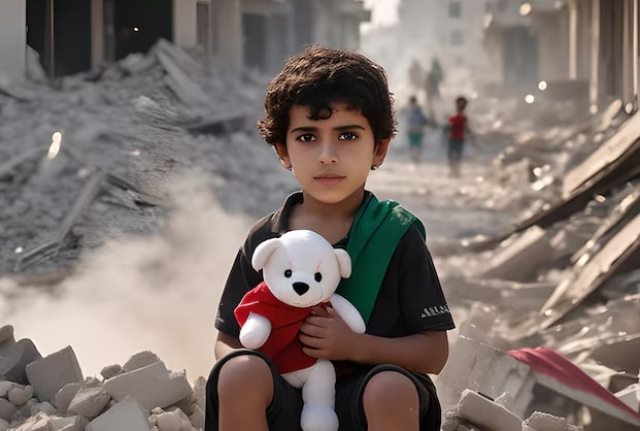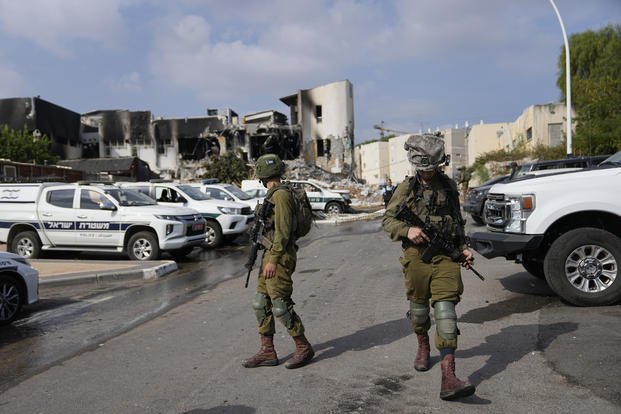October 7, 2024 marks one year of the Israeli aggression against the Palestinians in Gaza and West Bank. Meanwhile, during the last one year, many other nations like the regional power Iran and Israel also got entangled into a conflict, due to Israel’s operations to eliminate the entire top leadership of the Hezbollah and Hamas, and to render these organisations completely dismembered.
To achieve its overt objectives, Israel with full impunity attacked targets in Lebanon, Syria, and even Yemen. Acting as if it has been given the target to eliminate the maximum population of these countries.
Iran’s actions against Israel were termed as response to the ‘Axis of Resistance’, but who gave the right to Israel to act in this savage manner? While, it claims to have taken these actions against Iran, Iran’s actions against Israel are termed as aggression.
Further, the question of who is the aggressor, dominated the narrative last year completely ignoring and asking who is the intruder or usurper, hell bent on kicking the Palestinians from their own home land.
The reality is that Israel has morphed from an aggressor state to one of the world’s largest arms manufacturer and exporter. While this human tragedy was unfolding in the region, profits of Israel’s arms manufacturers were going through the roof.
This hidden aspect of the current war was explored by Turkey’s news outlet Anadolu Agency. As part of Anadolu’s series marking one year of Israel’s military campaign in Gaza, the agency spoke to Antony Loewenstein, author of the book, The Palestine Laboratory, on how Israel uses Palestine as a tool to boost its defence industry exports, by marking them as ‘field tested’.
He said the war on Gaza, which has claimed more than 41,000 lives seems to be a testing ground for Israel’s new weaponry.
“Israel has been testing and using new weapons and technology in its wars. And already, it has been trying to sell those tools and technologies at various global arms fairs since October 7,” the Sydney-based author told Anadolu. He said Israeli exports reached a record $13.1 billion in 2023.
Here we should be aware of the fact that what Israel sells in the global armament market is described as ‘field tested’. Now in the post WW II and Cold War, with no access to human Guinea pigs available to the arms and armaments manufacturers, Israel has found them in West Bank. Where at its own sweet will it launches attacks on Palestinians in their homes and later sell the same weapons labelled as ‘field tested’.
The irony is further compounded by the fact that most of these weapons are purchased by the neighbouring Arab states, most of whom profess to support the Palestinian cause, but in order to pursue their regional ambitions, they purchase arms from their supposedly arch-foe Israel.
As per a report of the think tanks Middle East Eye, Arab states that normalised ties with Israel under the Abraham Accords accounted for about 25 percent of Israel’s record $12.5bn in defence exports in 2022, signalling the deepening economic and defence links between the countries.
The 2022 price tag marked a 50 percent jump from the previous three years and a doubling in volume over the previous decade, according to Israel’s defence ministry. Drones accounted for 25 percent of the 2022 exports, while missiles, rockets or air defence systems amounted to 19 percent, Reuters reported.
Additionally, at another level, another pressing issue which must be handled by the international community, at the earliest is the human angle of the current conflict.
As per UN reports, the conflict so far has claimed at least 41,431 lives, another 95,818 injured, and 1.9 million displaced out of the estimated 2.2 million population.
A satellite imagery survey in July 2024 estimated that 63 percent of Gaza’s buildings had been damaged, including 215,137 housing units The UN Office of the Coordinator for Humanitarian Affairs reported in September that 46 percent of aid deliveries were impeded or denied outright to Palestinians in need.
As bombing and ground operations spread, 86 percent of Gaza was under mandatory evacuation orders by August, leaving al-Masawi, a sliver of sand already crowded with tents in the south, the only declared safe haven. The same month, the area was struck with a polio outbreak, twenty-five years after its eradication.
Amid the worsening situation, with no cease-fire in sight, aid organisations revived earlier warnings of impending famine. The humanitarian organisation Refugees International warned in September of increasing famine risk due to continued disruptions in aid delivery, bombing, and dislocations.
Further, more than seven hundred Palestinians in the West Bank and East Jerusalem have been killed since the war broke out, according to the Palestinian Authority Health Ministry in Ramallah. Since October 7, 2023, according to the UNOCHA report on September 25, 2024, Israeli authorities demolished 1,725 structures and displaced 4,450 Palestinians – double the rate of displacement in the preceding nearly one-year period.
Even before the September escalation of conflict across the Lebanon-Israel border, nearly 100,000 Lebanese had been displaced from their homes in the country’s south due to Israeli shelling. Meanwhile, approximately 63,000 Israelis were internally displaced from the country’s north due to Hezbollah’s rocket attacks.
But starting in late September 2024, Israeli strikes on Hezbollah and Palestinian targets in Beirut and across Lebanon killed hundreds of civilians and exponentially increased internal and cross-border displacement. More than One million Lebanese have now fled their homes in a matter of days amid Israel’s invasion and bombardment.
In addition, Syrian refugees and the large migrant worker population in Lebanon were also displaced, with many sleeping on the streets or in makeshift tents, unable to access buildings that were converted into shelters for Lebanese.
In a separate stark example of reverse migration, about 230,000 people – both Lebanese and Syrians – have fled across the border into Syria. Bringing the recent regional conflicts full circle with post-2011 Arab uprising displacement and crisis, returning home is an unsafe option for many Syrians who still fear repression under the government of Syrian President Bashar al-Assad.
Over several decades, the Middle East has experienced many large-scale, cross-border displacements for myriad reasons. The original forced displacement of Palestinians surrounding the creation of Israel in 1948 and subsequent conflicts created the world’s longest-standing refugee situation, with approximately Six million Palestinians living across the Levant. The first Gulf War, sanctions against Iraq in the 1990s and the 2003 US invasion of Iraq produced millions of refugees, with long-standing political repercussions for the region.
More recently, the 2011 Arab uprisings and the wars that followed in Syria, Yemen and Libya created millions of refugees, as well as internally displaced peoples, with nearly Six million Syrians still living in Turkey, Lebanon and Jordan and another Six million displaced inside Syria.
New layers of displacement in Lebanon – nationals, refugees, and migrant workers – as well as cross-border movement into Syria will put further strain on the underfunded system of humanitarian assistance.
Further, the current Israel-Hezbollah war in Lebanon is not the first-time conflict between the state and its neighbour to the north has preceded large-scale displacement. To eliminate the Palestinian Liberation Organisation, Israel invaded Lebanon in 1978 and again in 1982. Israel’s 1982 invasion led to the Sabra and Shatila massacres of between 1,500-3,000 Palestinian civilians – carried out by Israel’s Lebanese Christian allies – showing that military operations that do not distinguish between militants and civilians can lead to devastating impacts for displaced populations.
It is high time that various international organisations particularly the UN and nations like the US and UK, must step-up their efforts to get a cease-fire implemented in the region. The next step obviously should be to get Israel out of all occupied or annexed territories and then handle the issue of Israel’s burgeoning arms industry, but for that the West will have to curtail its own arms manufacturing and buying, by putting a stop to the arms race.
(The writer is a New Delhi-based commentator on international & strategic affairs, an interfaith practitioner, and a media consultant.)



